Tactical Breakdown: How the USA let its golden World Cup chance slip away
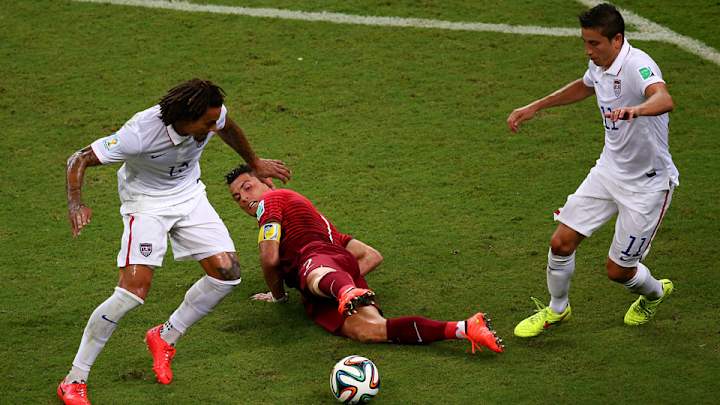
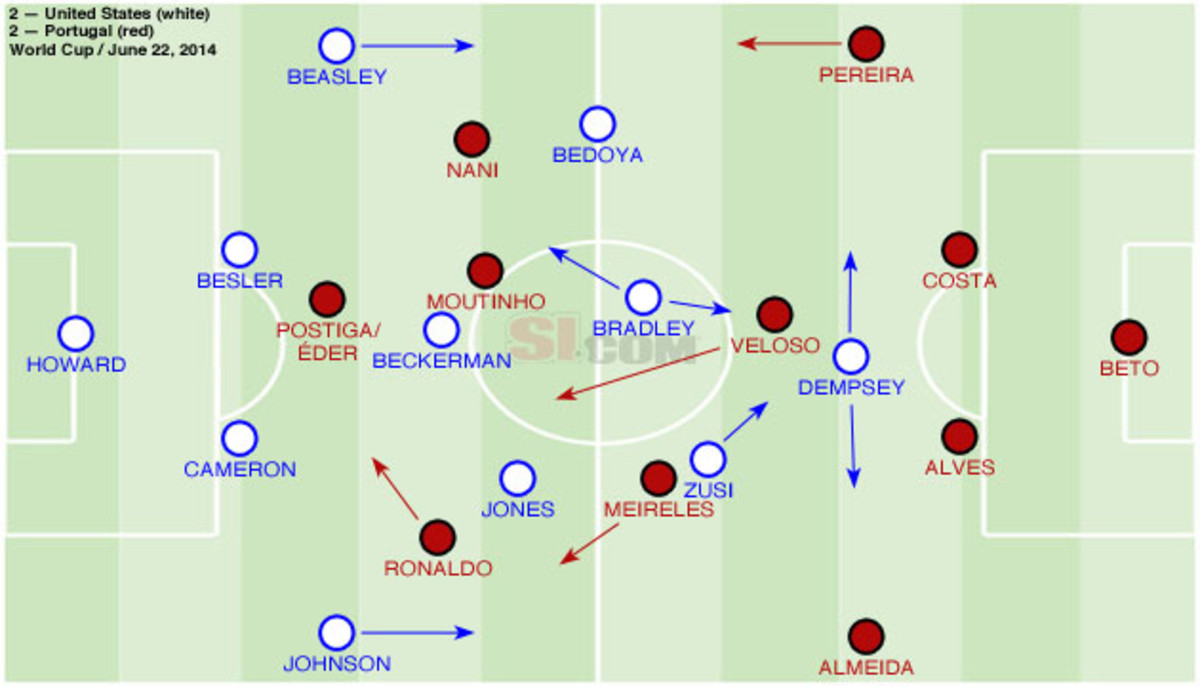
The United States had its foot on the throat of a depleted Portugal in the waning seconds on Sunday, but was forced to come away with a 2-2 draw, putting any knockout stage celebrations on hold. Unlike in its first group match against Ghana, the U.S. looked like a deserved winner, but individual errors snowballed into two points lost.
As has become standard under Jürgen Klinsmann, the U.S. played a four- or five-man midfield with a one- or two-forward set, depending on the situation. The formation could be called either 4-2-3-1, 4-3-2-1 or, mostly out of possession, 4-4-1-1.
Portugal stuck to a 4-3-3, with Cristiano Ronaldo floating dangerously between the left flank and central attacking spaces. Portugal had a sliver more of the ball numerically but struggled in attack and was exposed several times on its left.
Manager Paulo Bento never sorted out the problem created as Ronaldo stayed high, leaving room for Fabian Johnson to overlap. André Almeida started at left back, but Bento moved Miguel Veloso into the spot at the start of the second half, which proved to be a poor decision, as the U.S. attacked him and backtracking Raul Meireles.
Drawn At The Death: Five Thoughts on the USA's 2-2 draw with Portugal
Portugal struggled to find any rhythm with the ball, and Ronaldo never got comfortable. The U.S. kept enough numbers back to limit the Ballon d’Or winner to sporadic moments of 1-on-1 isolation, and without Portugal able to counterattack, the U.S. looked in control for the second half despite conceding very early in the match and absorbing pressure the first period.
Both American goals started on the right flank, one on a corner, and Johnson was their best player. His runs going forward were timed well, as he read the play to ensure a midfielder would be facing forward on the ball and able to provide a pass breaking Portugal’s high line of confrontation.
Graham Zusi tucked inside to give Johnson space to overlap and create 2-on-1 and 2-on-2 opportunities against Portugal’s left-sided players. The trouble in the first half was, when Johnson got forward, he didn’t have support or make the right decisions on the ball to develop it.
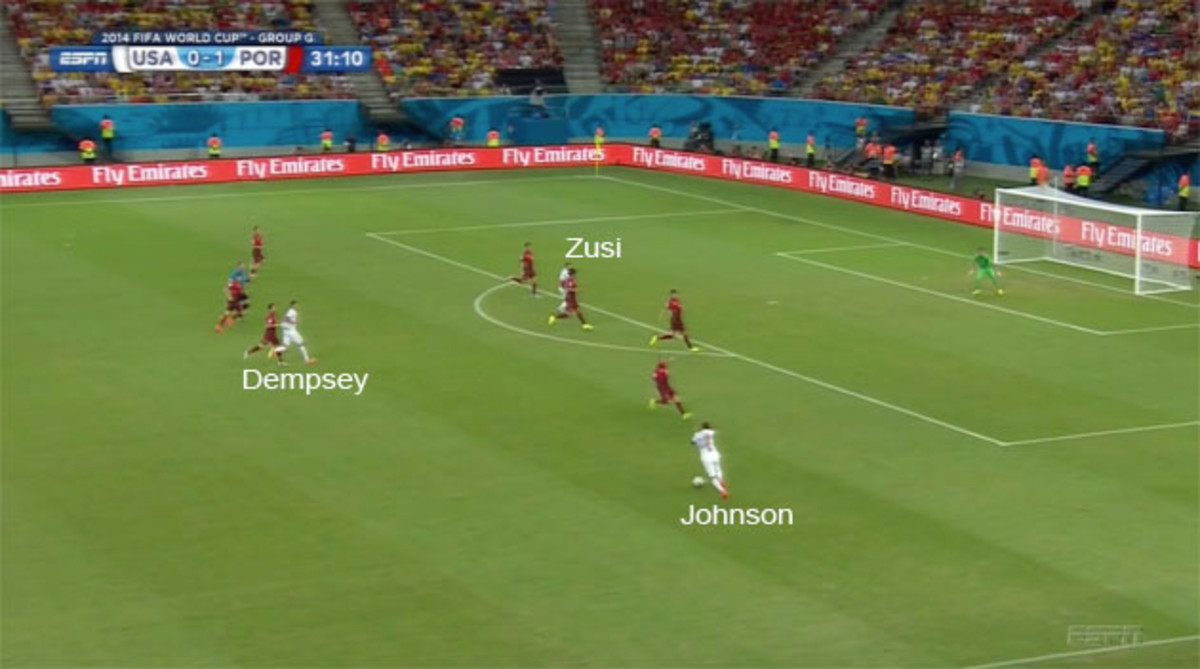
Despite holding a high line with its wingers and target striker, Portugal fell back quickly once the initial pressure was breached, inviting the U.S. to throw numbers forward. Part of the ploy was to give the Seleção a chance to counter, but the Americans were so cautious that they often ended up with no attacking capabilities.
Johnson would drive at defenders with the ball at his feet instead of staying patient to allow others to join him. With limited attackers to concern them, Portugal pressured and won the ball easily in its back half.
Michael Bradley’s shot saved off the goal line by Ricardo Costa in the 55th minute was the U.S.’s best look besides its goals. On that play, the U.S. had one more player in attack, but the location of the cross made the difference.
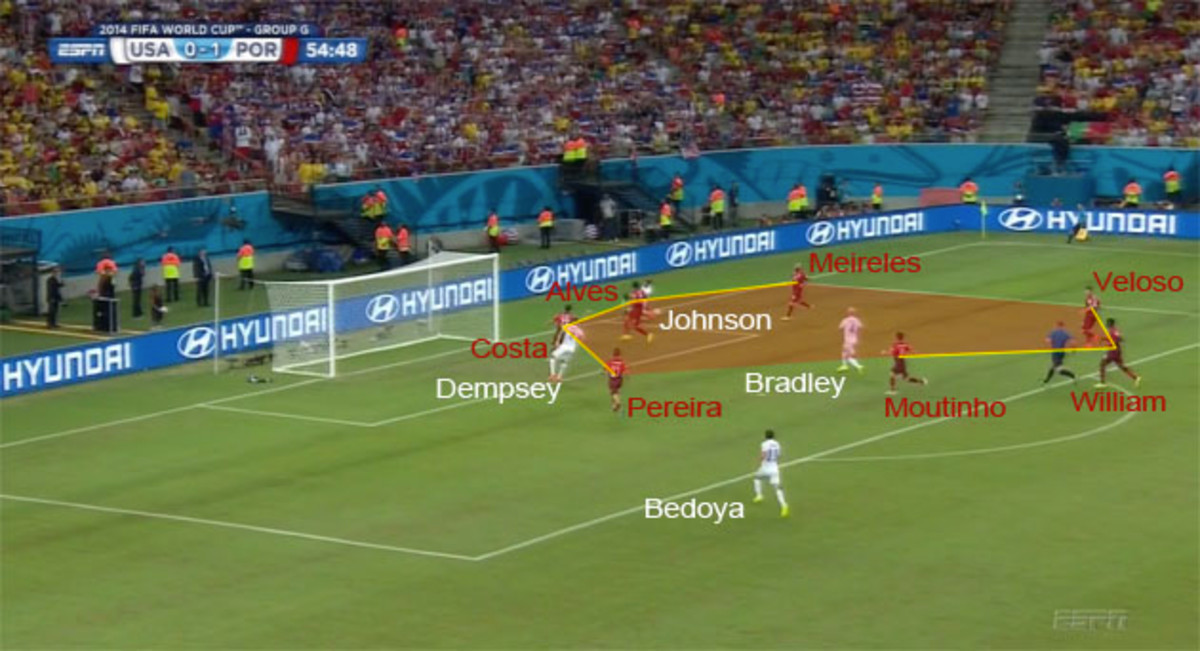
Instead of cutting inside prematurely, Johnson carried the ball to the endline and cut it back to Bradley on the ground. This is the most dangerous attacking situation in football because of the options it provides the attack and chaos it creates for the defense. It allows forwards to get in front of goal and midfielders to make late runs, the kind Bradley makes in his best attacking moments.
Goalkeeper Beto engaged Johnson, who blew past Meireles. The defenders retreated, leaving a gap between them and the recovering midfielders. They had to face the goal, meaning a cross could easily hit a defender and result in an own goal. If not, the receiving attacker (Bradley) would be facing forward with the ball at his feet and a gaping net in front of him.
It was a bad miss as much as it was a good block from Costa, as he couldn’t cover the entire 192 square feet of net. Bradley smacked his shot right into the defender, but it was obvious where Portugal was most vulnerable — and how.
With Klinsmann’s introduction of DeAndre Yedlin in the 72nd minute, the U.S. took more control and pushed forward on the back of Jermaine Jones’ stunning goal in the 64th. It was a positive, attacking substitution (the first Klinsmann had the opportunity to make this tournament, as his hand wasn’t forced due to injury as against Ghana) that provided the go-ahead goal late.
Bringing Yedlin on as a midfielder instead of a fullback, as Klinsmann was rumored to be ready to do heading into the World Cup, is something Seattle Sounders manager Sigi Schmid could adopt. Yedlin’s individual defending is his weakness, but putting him in the middle block compensated for that and magnified his assets (a willingness to bomb forward with his natural speed).
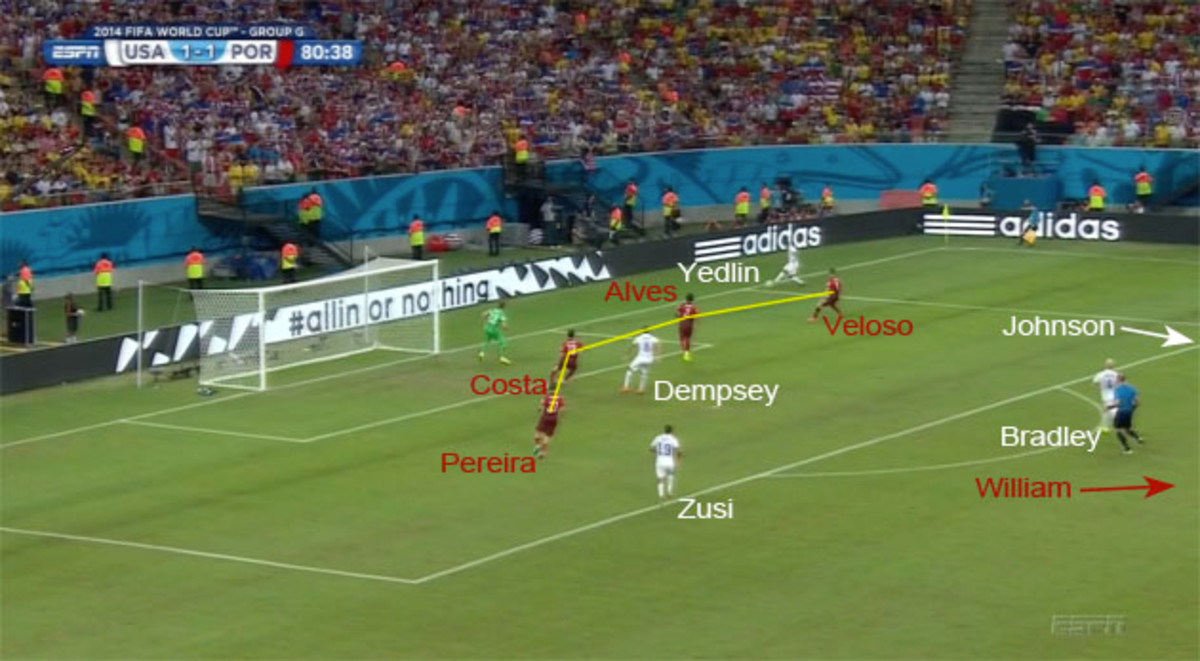
On the play that led to Clint Dempsey’s goal, Yedlin and Johnson both got down the line and into the penalty area (by the time the ball popped out to Zusi, Johnson was lingering on the opposite edge). The midfield cover came slowly, and when it did, it was just William tracking back.
The U.S. looked fitter than Portugal all night, never more apparent than in the midfielders’ lack of backtracking when out of possession. By the time Zusi crossed to Dempsey on the U.S.’s 81st-minute goal, no more numbers had fallen back to support a defensive line that was again facing its own goal and — for once — outnumbered.
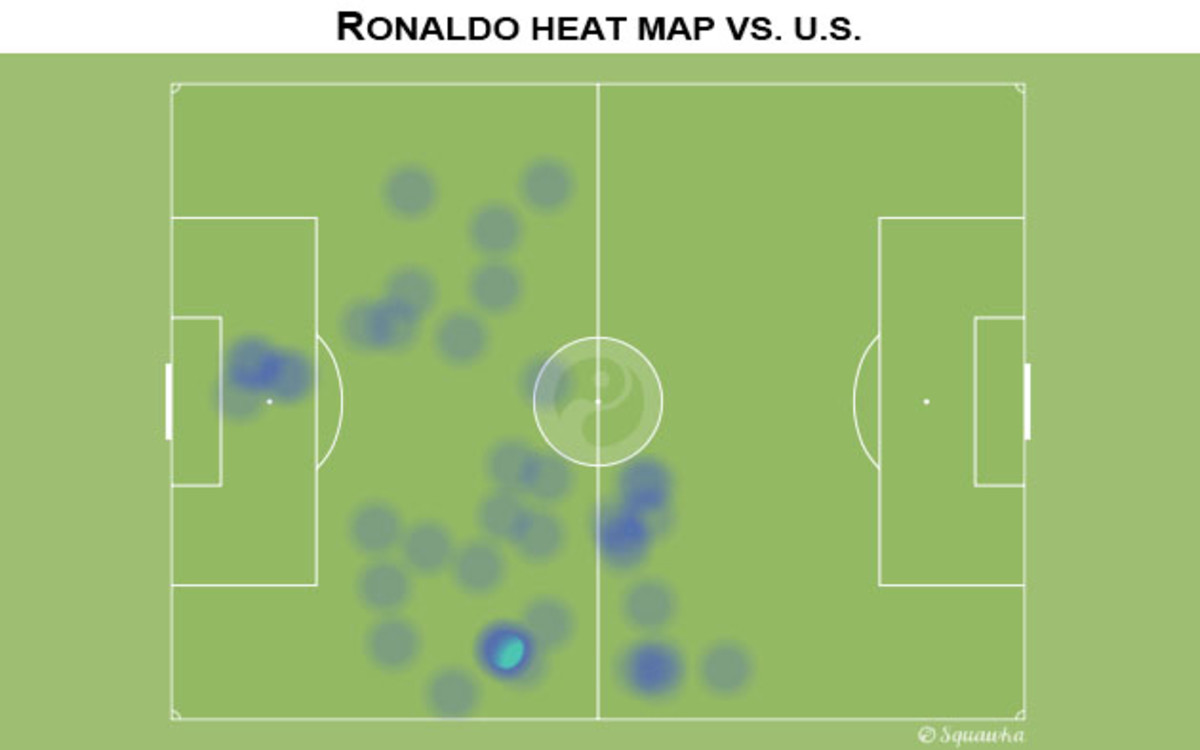
Ronaldo hardly set foot in his own half of the field, and he only had momentary isolation points. These flashes of brilliance showed that a Ronaldo at less than 100 percent health is still a dangerous opponent, but his supporting cast didn’t have the same quality.
Portugal focused its efforts on the flanks, but its crossing was no better than Ghana’s on Monday except for Ronaldo’s late effort. Looking for balls into the box played into the U.S.’s athletic strengths. Portugal capitalized just once on Ronaldo’s ability, as he sent an inch-perfect cross for Silvestre Varela to head home in the fifth minute of stoppage time.
The U.S.’s weaknesses continue to be technique and intelligence. Portugal’s first goal came from the former, Geoff Cameron’s scuffed clearance on Nani’s opener being one of several weak efforts in similar situations, while the equalizer with the last kick of the match came largely from the latter.
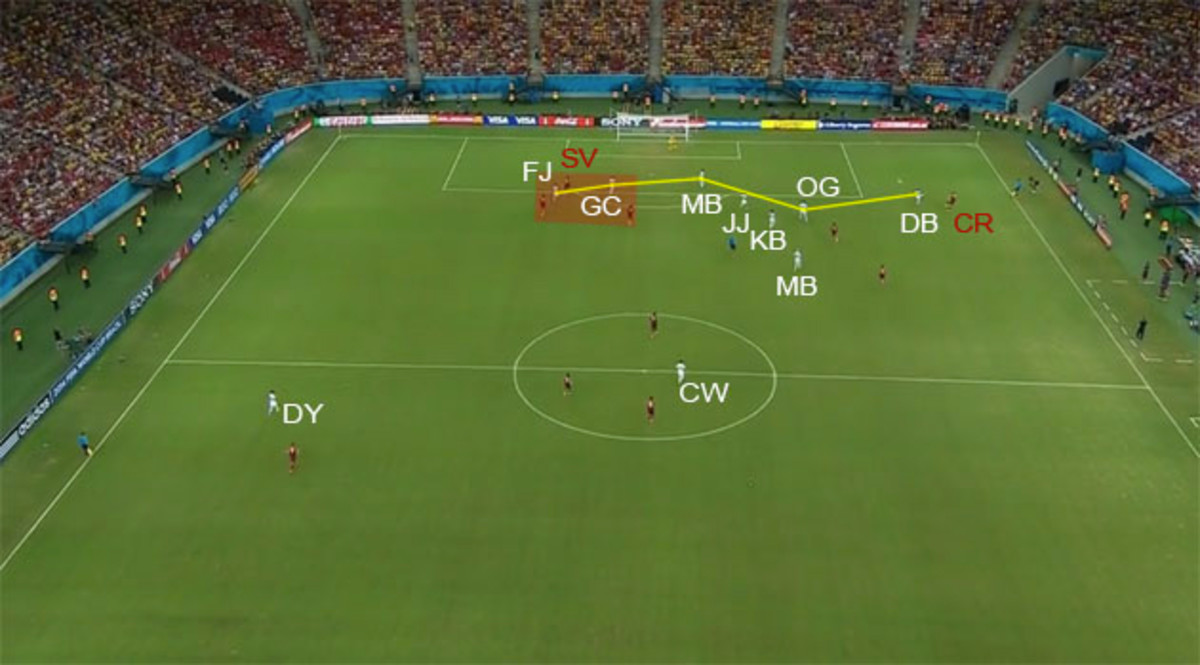
Bradley gave possession away cheaply in midfield after bringing down a bouncing ball under no pressure. The U.S. looked unbalanced in the back, at least partly as a result of the giveaway.
USA eyes bigger picture after letting World Cup chance slip vs. Portugal
Omar González and Kyle Beckerman both failed to close down Nani before he completed the wide pass to Ronaldo, despite González having fresh legs and Beckerman being in a spot to provide easy cover. Beasley couldn’t dive into a tackle on Ronaldo and risk being left for dead, so he stood the attacker up and forced him to serve the ball into the penalty area.
Ronaldo picked the perfect pass after looking up to see a 3-on-2 advantage at the back post. Yedlin, the right winger, never tracked back from losing the ball in the corner. He was higher than the lone striker, Chris Wondolowski, when the goal was scored.
Johnson recovered but still allowed Varela’s run behind Cameron, who looked unaware that the attacker was there. Cameron’s body shape was closed off from the back post, so he couldn’t know Varela was there without proper communication.
That series of individual errors and one at the start of the match negated Klinsmann’s superior tactical set-up. The U.S. should have beaten Portugal, but Cameron and Bradley’s errors lost the team two crucial points.
Bradley has struggled since Klinsmann moved him out of the holding block and into a playmaking role. The manager has to bear the blame for shoehorning players into positions inappropriate to their strengths, Bradley being chief among them.
At the same time, for a player as important as he is to the cause, he should know kicking it to the moon (the ball or the opponent, to stop the counterattack) would be preferable in that late situation.
So instead of six points after two games, the U.S. sits on four. It’s a disappointing prospect to face Germany and need a result when it could have been a much less stressful game, but the fact that the U.S. has a chance at all in the final game of Group G remains impressive.
